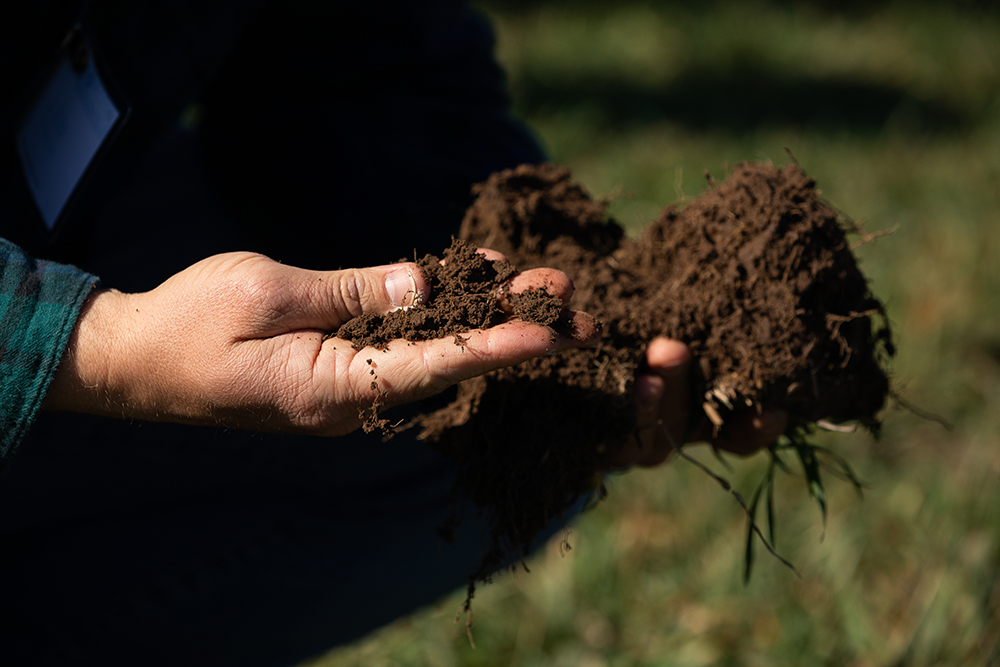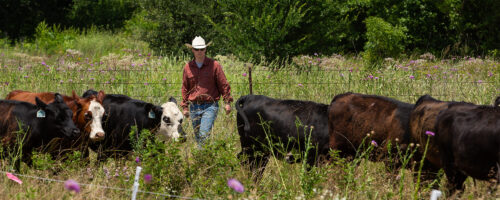Make Your Soil Work For You To Optimize Ranch Production And Profit
Optimizing your ranch’s soil health can help reduce inputs, increase available forage and improve your bottom line.
Many ranchers are in a “more is best” mindset — more production, more livestock, more income. Yet, maximizing your ranch’s output doesn’t always maximize your profit, because this constant pressure to produce more sometimes overlooks the input side of the equation, as well as potential negative effects on soil and other resources.
Hugh Aljoe, Noble Research Institute’s director of producer relations, recommends instead of maximizing a ranch’s production, ranchers make their goal to optimize it.
Optimizing your ranch’s production strikes the balance between inputs (direct costs, labor, equipment) and gross output (actual production and revenue), which makes the operation more profitable. And one way to optimize your land’s production is to put your soil to work. Healthy soil stands as the cornerstone of a profitable regenerative ranch, because it can help ranchers simultaneously reduce inputs and increase net margins, and often increase forage production with a few years of adopting regenerative management.
Aljoe shares four reasons to put your soil to work on your ranch:

1. Save money: use what you’ve got
Inputs typically are costly, and they’ve gotten more costly over the course of the last few years, Aljoe says.
“So the low-hanging fruit for people with introduced pasture and grazed cropland is to reduce inputs. On Noble Ranches, we really learned to make good use of what we already had first, and then have a better understanding of what that additional input will provide and be able to assess whether that’s going to be worthwhile or not,” he says.
“Long story short … as we begin to pull inputs from the system and learn to make do with what nature provides, there’s some significant cost-cutting.”
Some ranchers may be stuck in an endless cycle of applying fertilizer and chemicals to maintain pristine improved pastures. Yet, the cost of these added inputs doesn’t stop at the ever-increasing fertilizer bill; it also takes a toll on the land.
“One of the misnomers that we have with introduced pasture is if we just fertilize it and take care of the weeds, we can continue to perpetuate this indefinitely without detriment,” Aljoe says. “But we just can’t put enough back of what’s being removed at the rate that needs to be cycled to have a highly functional nutrient cycle and ecosystem.
“We spend a lot of effort and money on introduced pastures trying to keep them productive and pristine, weed-free monocultures. We have come to believe that by applying nitrogen, phosphorus, potassium, occasionally lime and other macro- and micro-nutrients we can replace, mimic and enhance what nature does in native grazing lands. However, synthetic N, P, and K are not the same amendments as what nature and regenerative grazing provides to the soil; and the temporal benefits that come occur at the expense of soil health.”
The regenerative ranching approach starts with simply using what you’ve got. By beginning to manage your land to improve soil health, and by maintaining plant materials to cycle and feed the organisms and the soil in addition to the cattle, ranchers can stop using fertilizers and chemicals on their land. Instead, the natural processes – such as the water cycle, energy flow and community dynamics – work together to create a highly functional, self-sustaining ecosystem. When your soil works optimally, as nature intended, it produces more forages.

2. Increase green by optimizing soil health
Healthy soils produce more green — literally and sometimes figuratively. Healthy soils absorb more rainfall with less runoff. They also grow more forages over the year, which keeps the ground covered and protected, according to Aljoe.
“Within the year, it just adds grazing days over a period of time that builds carrying capacity or forage production, and therefore gives us opportunities to enhance our stocking rate or better utilize our stocking rate with different enterprises,” Aljoe says.
But, having more available forages is just part of the optimized ranching equation. Mindfully managing these forages is of the utmost importance. Overgrazing can set back your stand of grass and hamstring livestock production. Think of your lawn as an example.
“When you mow your yard really short, down to about 2 inches, you don’t have to go back and mow it every week,” Aljoe says. “But if you mow it at a height of 3 to 3.5 inches, you have to mow it the following week because it recovers so fast. It’s the same thing with the pastures.”
Ideally, he explains, we want to be able to grow more grass throughout the growing season. The easiest way to do that is not graze pastures short. Then, pastures are ready to graze again sooner because it only has to regrow leaves and not structural parts of the grass plant.
“If we take all the forage by grazing it way short, we may never reach the pasture’s potential, because plants have to regrow from the ground up and not just the leaves,” Aljoe says. “That pasture may never fully recover before we are ready to graze it again. The plants just can’t grow back fast.”
So, by not allowing grazing livestock to remove too much forage from a field, ranchers can keep the ground covered, thereby increasing organic matter, decreasing weed pressure and encouraging forage rest and regrowth.
This careful attention to detail also saves ranchers dollars when it comes to supplementing their grazing livestock. Noble Ranches have saved on supplements by rotating cattle more often to help manage soil health. Not only does it help the pasture rest and recover, but it also ensures cattle always have nutritional forages available.
This year, Noble Research Institute’s ranch managers hope to feed hay for fewer than 30 days, Aljoe says, by making the most of their forages and keeping their soil healthy.
Any way you look at it, healthier soils produce more green.

3. Add profitability by exploring new ways to use available forages
Having plenty of available forage for cattle grazing is certainly a goal of most ranchers. But what if their management decisions were made based on what is best for their land instead of their cow herd? Often ranchers focus on their cattle production when making decisions, yet by pivoting their decision-making process to become more land-centric, ranchers may have more opportunities to make money.
A simple example of this land-centric approach would be stocking fewer cattle to ultimately realize more profits by managing the ranch with fewer added inputs. But looking beyond cattle could also mean adding a complementary grazing species, such as sheep or goats, as an added income source. Or reviewing your marketing strategy based on available forage supply. If you have ample forage, you might be able to capture more added value by backgrounding your calves on grass to heavier weights rather than selling them at weaning.
“You know, it’s really easy for us to put a value on a cow because we sell its calf,” Aljoe says, “but we’ve got to treat the land like it’s got to sustain us into the future.”

4. Observe and learn from real-world results
Aljoe sees producers who manage their ranch for optimal soil health become more profitable, and he experiences it firsthand. On one of the Noble Ranches, staff saved about $50,000 on fertilizer when they started managing the 3,000 acres of bermudagrass pastures for soil health.
They also saved more than $15,000 by not spraying the weeds on that ranch. Which, as Aljoe will tell you, means the ranch isn’t always a pristine or pretty picture. The pastures were admittedly weedy yet through regenerative grazing we utilized many of the weeds or forbs as a forage (forbs are usually higher in crude protein and energy than grasses). As the soil cover increased, weeds or forbs became more scarce and diverse. Interestingly, using regenerative grazing, those pastures yielded 30-40% more grazing days — “weeds” and all.
He has also seen some stark examples of how an optimized soil-health management style yielded more profit. One rancher weathered the 2011-2012 drought by being mindful of his land’s well-being. After monitoring winter rainfall leading into the spring, that rancher could see there would likely be a drought. So, he pared down his cow herd by a quarter, selling older pairs and problem cows for good money before the market reacted to the coming drought.
“He said, ‘I’m going to get rid of everything that is older, has bad udders, poor performers, ugly, I don’t like and has ever looked at me the wrong way,’” Aljoe recalls.
With a lighter stocking rate, that rancher easily made it through the drought with plenty of available forages. In fact, that year ended up being one of the most profitable his ranch had. To sweeten the deal, the rancher was in the position to buy the heart of his neighbor’s cow herd when his neighbor no longer had the forage needed to sustain the cattle during the drought.
So, that soil-centric rancher cared for his land, and his land rewarded him greatly with a profitable year during a challenging time plus new, improved genetics to continue to build his cow herd.
Another rancher sold all his cattle to focus on managing his land. According to Aljoe, his healthy, ungrazed pastures soon caught the eye of a local cattle producer who had rented the land for the last several years. Not only did the producer agree to graze the cattle in a way which would keep the rancher’s land healthy, they also provided a steady revenue stream which proved more reliable and profitable than the rancher’s own cattle ever had.
Ultimately, managing land in a regenerative fashion with a focus on what’s below the ground can yield more significant profit, and these management decisions can be implemented slowly and steadily over time to improve both the ranch and the bottom line. Aljoe often recommends producers start with low-cost improvements with the potential for big returns, such as temporary fencing to more intensively manage grazing livestock to optimize soil health.
“One of the common misperceptions out there is you’ve got to put a lot more infrastructure in right away,” he says. “You always start with what you already have. Then you want to put your first dollars where you’re going to get your biggest return — your more productive pastures. And start with a manageable size area. Step into regenerative grazing and soil health management at a scale that you can successfully manage.”
As Aljoe says, the most crucial part of managing your ranch is constantly evolving and bettering your practices.
“I think the big thing is we never stop learning,” Aljoe says. “You know, we have spent most of our time looking at the cow. We’ve got to begin to look not only at the cows but also at the pasture and below ground. We’ve got to look at the soil.”



Comment